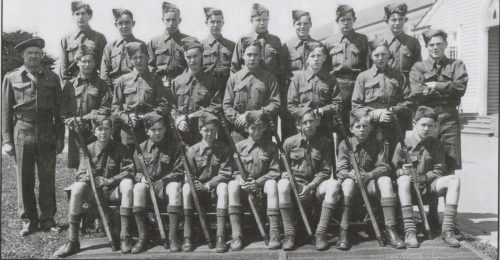
As Howick and districts count down to the 175th anniversary, the Times continues its series by Alan La Roche giving readers a glimpse of life as it used to be. The countdown began at the 170th in 2017
When war was declared on Father’s Day September 1939, a group of enthusiastic Howick men of the Mounted Rifles Territorials with patriotic support of Great Britain were the first in Auckland to volunteer at the recruiting centre.
More than 150 men and women from Howick served overseas in this awful war. Almost immediately, an emergency team prepared for a possible invasion with first-aid training of women’s groups and Howick schools. Everyone had to help.
The Home Guard groups at Howick, Pakuranga and Bucklands Beach used all available manpower to establish five tank traps at Panmure Bridge, the end of Bell Road, the end of Cook Street and at Musick Point. They used large, long heavy logs that would slow down an invasion.
Some had large trees partially cut ready to fall and block the road. Due to the narrow width of the tank traps, Howick carrier Dick Newton had to take his truck via Otahuhu to get to Auckland. All men aged 16 to 66 years old were expected to join the Home Guard if not on essential services.
Most homes had an air raid shelter nearby stocked with emergency foods. Barbed wire fences were erected across Cockle Bay, Howick and Mellons Bay Beaches supported by pine logs donated from the plantation at the end of Cook Street.
Some young swimmers tore their togs and legs wriggling under the sharp barbs. The army requisitioned several trucks and motorbikes upsetting owners. Most farmers used horses to pull loads and plough fields.
Rubber was eventually unprocurable, so farmers had leather boots. Gun emplacements were urgently built in 1942 after the Japanese had attacked Australia. There was one at either end of Cockle Bay and Howick Beach and one at Mellons Bay. Another was near the entrance of today’s Macleans College protecting Bucklands and Eastern Beaches as well as one at the northern end of Bucklands Beach.
The Home Guard and school students dug defense trenches zigzagging beside the Tamaki River, the Mangemangeroa and Turanga Valleys. The Home Guard practiced and patrolled these.
All streetlights were disconnected in Howick in 1942. It was illegal to park overnight on the side of the road. Car headlights were dipped on the left side and black tape put over the right side. Parking lights were covered and tail-lights had seven-watt bulbs. If a streetlight was visible from the sea it was shrouded. Some put their cars up onto blocks of wood and used a bicycle instead as petrol was rationed and tyres needed repairing often.
Rationing of tea, sugar, flour, butter, meat and clothing was enforced and you were encouraged to be a loyal customer of your grocer, baker or butcher. Sugar sacks and flour bags were valued for many uses. Many students had singlets or undergarments made from flour bags. Senior school students were sent to help harvest potatoes at Pukekohe or haymaking at Howick. Some essential workers built fake Hudson bombers at Mangere to fool any invaders.
In 1944 the Howick Town Board was actively fighting the Brown’s Island sewerage scheme that would pour partially treated sewage onto our beaches. All household wells were cleaned out ready for use if we were invaded and our reticulated water supply was damaged.
Returning servicemen were given a discount to buy subdivision sections. Howick attracted many from Europe escaping to a more peaceful and safer part of the world. Howick celebrated the end of WWII even though rationing continued until the early 1950s.
- Alan La Roche MBE
Howick Historian
alanlaroche@xtra.co.nz






